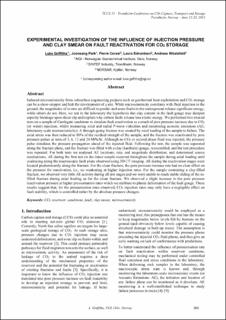| dc.description.abstract | Induced microseismicity from subsurface engineering projects such as geothermal heat exploitation and CO2 storage can be a show-stopper and halt the development of a site. While microseismicity correlates with fluid injection in the ground, the magnitudes of events are difficult to predict and some faults in the underground release significant energy, while others do not. Here, we test in the laboratory the hypothesis that clay content in the fault gouge may dampen asperity breakage upon shear slip and explain why certain faults release less elastic energy. We performed two triaxial tests on a sample of Castlegate sandstone to simulate fault reactivation as a result of pore pressure increase due to CO2 (or water) injection, whilst measuring axial and radial P-wave velocities and monitoring acoustic emissions (AE; laboratory scale microseismicity). A through-going fracture was created by axial loading of the sample to failure. The axial stress was then reduced to 80% of the residual strength of the sample, and the fracture was reactivated by pore pressure pulses at rates of 3, 6, 12 and 24 MPa/hr. Although no CO2 or second phase fluid was injected, the pressure pulse simulates the pressure propagation ahead of the injected fluid. Following the test, the sample was separated along the fracture plane, and the fracture was filled with a clay (kaolinite) gouge, reassembled, and the test procedure was repeated. For both tests we analysed AE locations, rate, and magnitude distribution, and determined source mechanisms. AE during the first test on the intact sample occurred throughout the sample during axial loading until coalescing along the macroscopic fault plane observed using 3D CT imaging. AE during the reactivation stages were located predominantly along the fracture. For the clean fracture, the pore pressure increase rate had no clear effect on the pressure for reactivation, i.e., no weakening at higher injection rates. For the sample containing a clay-filled fracture, we observed very little AE activity during all test stages and we were unable to reach stable sliding of the infilled fracture during axial loading as for the clean fracture. We observed a slight increase in the pore pressure reactivation pressure at higher pressurisation rates which we attribute to plastic deformation of the fault gouge. These results suggest that, for the pressurisation rates observed, CO2 injection rates may only have a negligible effect on fault stability, which is controlled rather by the absolute pressure changes. | en_US |

